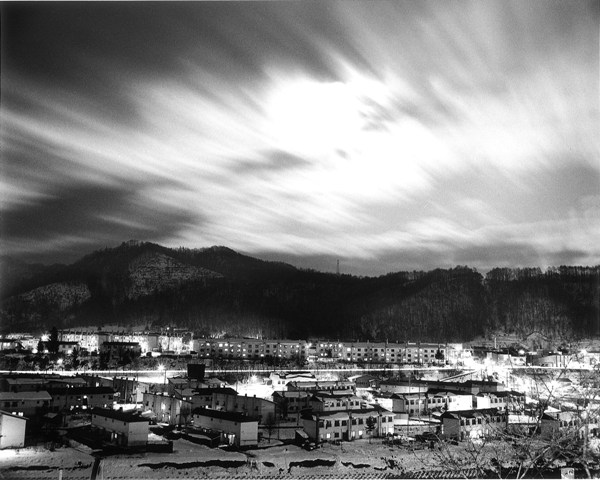 |
 |
|
|
Photographers of Japan Vol.14 "Kazama Kensuke"
Kazama Kensuke was born in Tsu City, Mie Prefecture in 1960. After graduating from Mie Prefecture Kameyama High School, he moved to Tokyo in 1978, where he became a musician photographer. However,? he grew tired of the kind of photography which forced him to take certain photos of only certain subjects, and with camera in hand, set off on a wandering walk through the country. During his travels, he was struck by the coal mine structures of Yubari, Hokkaido, and moved to Nanporo City, Hokkaido, in 1987, then settled in Yubari in 89.
Yubari, once made wealthy by the coal industry, saw the continuous closure of its mines, and was in decline. But instead of pursuing the typical image of “coal mines = dark”, Kazama used his photographs to capture the ferocious energy and shining vitality of that “coal mine heritage” in the demolished miner towns, weathering structures, and enormous steel beams of the generators. He put monochrome film in a 6x7 camera with a contrast-strengthening filter and shot with long exposure. Kazama’s photos of Yubari carry a certain grief for those things going to ruin, but at the same time reveal the unique beauty of the landscape.
In Higashikawa International Photo Festival in Higashikawa Town, Hokkaido, Kazama exhibited his works in its outdoor photography exhibition every summer, and received the 18th Special Award in 2002. In 2005, the Yubari photos he had taken were compiled and published as the photo collection, “Yubari” (Jurousha), and the following year, he was awarded the Japan Photographers Association New Photographer Award as well as the “Photography Association” Award. In his review, photographer Onishi Mitsugu wrote, “The landscape reflected in Kazama’s eyes is not simply nostalgia for a time gone by - it radiates a powerful presence, the spirit of that time, proof of the people who lived there in the traces of their lifestyle left behind.” With the publication of this photobook and its award, Kazama’s work gathered attention from many corners of the photography world.?
In 2006, Kazama built a home and atelier in Sayama City, Saitama Prefecture, to which he relocated. At around this time, he began to delve into creating drawings as well as photographs. In 2015 he moved yet again to Tateyama City, Chiba Prefecture, where he opened “Gallery Kazama”. However, his health suddenly deteriorated, and he passed away in his home in June, 2017. When revisiting the only photo collection from his lifetime, “Yubari”, you can feel his happiness from encountering this subject which inspired him, and his confidence in the creation of his work. If he had had the opportunity to find a new theme, I’m certain he would have borne even further substantial works
 KAZAMA Kensuke 「夕張物語(12)」 ゼラチンシルバープリント 23.8x29.7cm サインあり BacknumberVol.16 "Ogawa Takayuki (1938 - 2008) − explorer of “shape” through photography"Vol.15 "Kitai Kazuo - Capturing “a scene I once saw…”" Vol.14 "Kazama Kensuke" Vol.13 "Narahara Ikko - Double Vision" Vol.12 "Q Ei and Vol.11 "Fukuhara Shinzo 1883-1948 -- Japanese Landscape Photography" Vol.10 "The city observer’s gaze Akihiko HIRASHIMA (1946~)" Vol.9 "Hitoshi FUGO 1947- -- The unusual world of works which fuses thought and technique" "ETSURO ISHIHARA - THE EXTRAORDINARY GALLERIST WHO TURNED PHOTOGRAPHY TO ART" Vol.8 "Iwata NAKAYAMA (1895-1949)" Vol.7 "KISEI KOBAYASHI (1968-)" Vol.6 "Tamiko NISHIMURA (1948-)" Vol.5 "Shigeo GOCHO (1946-83)" Vol.4 "Shoji UEDA -Locality open to the world-" Vol.3 "Yu OGATA, ICHIRO OGATA ONO -Dyslexia's picture of the world-" Vol.2 "Eikoh Hosoe's theatrical imagination" Vol.1 "maroon" -- Whereabouts of new works by Hiroshi Osaka
|
| Gallery TOKI NO WASUREMONO / WATANUKI INC. LAS CASAS, 5-4-1, Hon-komagome, Bunkyo-ku, Tokyo 113-0021 JAPAN Tel +81-3-6902-9530 Fax +81-3-6902-9531 E-mail:info@tokinowasuremono.com http://www.tokinowasuremono.com/ Open Tuesday-Saturday 11:00-19:00 Closed on Sundays, Mondays, National Holidays Copyright(c)2012 TOKI-NO-WASUREMONO/WATANUKI INC. All rights reserved. |